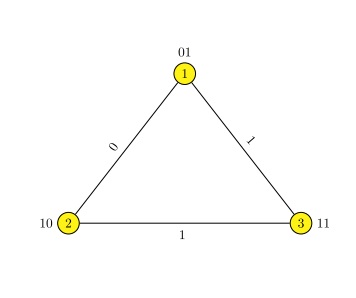Suppose $n_2$ denotes the binary representation of the integer number $n$. Let $X_2(n)=[1_22_2\ldots n_2]$,$n\geq3$, be a binary vector which is obtained by concatenating of binary representation of the numbers from $1$ to $n$. Also, let $X_2^m(n)$,$0\leq m\leq n-1$,denotes the cyclically $m$ shift of the entries of the vector $X_2(n)$. For example, we have $$X_2^0(n)=X_2(n)$$ $$X_2^1(n)=[n_21_22_2\ldots(n-1)_2]$$ $$X_2^2(n)=[(n-1)_2n_21_22_2\ldots(n-2)_2]$$ and so on.
For two binary vectors $X$ and $Y$ (with same length), suppose $|X\cap Y|$ denotes the number of ones common to both $X$ and $Y$.
The conjecture is:
Let $n\geq 3$ be a natural number. For all $m$ and $k$, we have $|X_2^m(n)\cap X_2^k(n)|\cong 0 \mod 2$ if and only if $n=2^s-1$, for some integer number $s$.
Note: I use $\lfloor \log_2n\rfloor +1$ bits for binary representation of each integer number from $1$ to $n$. So, fedja's example is as follows:
$X_2(3)=[011011]$, $X_2^1(3)=[110110]$ and $X_2^2(3)=[101101]$. We can see the claim is true.
The conjecture is tested for many integer numbers. I appreciate any helpful comments and answers.
$\textbf{Added later}(19/09/2017)-9:03:$ The other easy way to see the problem is as follows:
For the natural number $n\geq 3$, let $G$ be a graph with $n$ vertices such that the vertices of $G$ are labeled by numbers $1$ to $n$. Then we represent each vertex label in uniform binary form and we connect the vertex $i$ to the vertex $j$ with the edge weight equal to the number of ones common to both $i_2$ and $j_2$. Note that the resulting graph is complete and each edge has a weight between $0$ to $\lfloor \log_2n\rfloor$. See the below example:
By this representation, we have an equivalent graph theory problem. In this context we must show that the summation of the weights of edges of some special subgraphs are even or odd.

